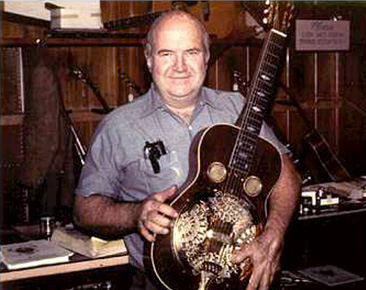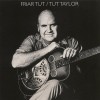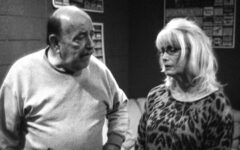
 Tut Taylor, The Flatpickin’ Dobro Man, died on Thursday morning April 9, 2015, at the Wilkes Regional Medical Center in North Carolina. He was 91 years old.
Tut Taylor, The Flatpickin’ Dobro Man, died on Thursday morning April 9, 2015, at the Wilkes Regional Medical Center in North Carolina. He was 91 years old.
The Dobro virtuoso was a US Army and Navy veteran.
Robert Arthur Taylor, Sr. was born in Milledgeville, on the banks of the Oconee river, Baldwin County, Georgia, on November 20, 1923. His family wasn’t blessed with any great riches, except for music. By the age of 10 Taylor had learned how to play the banjo. Two years later he learned how to play the mandolin.
When he was 14 years old he heard Pete Kirby, better known as Bashful Brother Oswald of Roy Acuff’s Smoky Mountain Boys, playing Dobro on the Grand Ole Opry and was so attracted to it that he was instantly determined that he would learn to play the instrument. The problem was, he didn’t know what the instrument was called. So, enterprisingly, he wrote to Roy Acuff. Taylor got a reply from Acuff’s wife Mildred and he promptly went out and purchased a Dobro.
Without any means to tell him otherwise, Taylor played the Dobro with a flat-pick – the same way that he played the mandolin – rather than the conventional way, with thumb-pick and finger-picks. He held the slide in an unorthodox manner also.
None of this hindered Taylor as he had the dexterity to play the rolls just as well as those playing in the three-finger style.
Initially, Taylor played for his own pleasure.
 During the early 1960s he, along with Glen Campbell and members of the Dillards, joined the Folkswingers, the group releasing three albums, two in 1963 and one in 1964, on the World Pacific label.
During the early 1960s he, along with Glen Campbell and members of the Dillards, joined the Folkswingers, the group releasing three albums, two in 1963 and one in 1964, on the World Pacific label.
Also in 1964 Taylor released a solo album, Dobro Country (World Pacific WP 1829), with backing from Clarence and Roland White, Bill Keith, Billy Ray Lathum, Chris Hillman and Victor Gaskin.
That same year he was featured on Porter Wagoner’s The Bluegrass Story (RCA 2960).
Later in that decade Taylor joined the Dixie Gentlemen – the legendary fiddler Vassar Clements was in the band also. They released the album Blues & Bluegrass (Tune TRC 1001) in 1967.
When Taylor moved to Nashville he, along with instrument dealer George Gruhn and luthier Randy Wood, opened the instrument shop GTR, a predecessor to Gruhn Guitars.
In another initiative Taylor, Wood and Grant Boatwright opened The Old Time Pickin’ Parlor, which became a very big attraction for bluegrass musicians from 1971 to 1977.
Meanwhile Taylor played mandolin on David Bromberg’s eponymous LP (Columbia C 31104).
More memorably he became a member of John Hartford’s band and helped with the recording of the iconic Aero Plain album (Warner Brothers WS 1916). The 1971 release influenced innumerable progressive bluegrass musicians. Taylor’s Dobro playing on this LP helped to define his bluesy style.
 During the 1970s Taylor recorded three of his own albums, Friar Tut (Rounder 0011) – this release led to his induction into the Dobro Players’ Hall of Fame – Old Post Office (Flying Fish FF 008) and the highly significant Dobrolic Plectoral Society (Takoma D 1050).
During the 1970s Taylor recorded three of his own albums, Friar Tut (Rounder 0011) – this release led to his induction into the Dobro Players’ Hall of Fame – Old Post Office (Flying Fish FF 008) and the highly significant Dobrolic Plectoral Society (Takoma D 1050).
He can also be heard playing Dobro on Leon Russell’s Hank Wilson’s Back and Norman Blake’s Super Jam Session.
Meanwhile, he produced albums by Bashful Brother Oswald, Norman Blake and Mark O’Connor.
In 1994 Taylor and Jerry Douglas co-produced The Great Dobro Sessions (Sugar Hill Records 2206), an album that included a superb selection of Dobro players and that would go on to win a Grammy Award for Best Bluegrass Album.
Over the years he demonstrated great artistic talents as a sign-painter, including a design that he painted on a mandolin case, a gift for Bill Monroe; and as a luthier, he was the designer of the Tutbro guitar. He was a collector of a variety of instruments and bluegrass music-related paraphernalia. Also, he was an early recorder of shows, jam sessions and private picking parties, amassing a collection of tapes that document bluegrass music for the past 50 years. There is an amazing treasure shrove of audio goodies available at the Taylor’s Steam Powered Preservation Society website.
In 1997 Taylor released Flat Pickin’ in the Kitchen (Tutlee 1001) ably assisted by old picking buddy Norman Blake, among others. It featured 24 tracks from the period 1970 to 1973, excavated from Taylor’s archives.
Exactly ten years later Norman and Nancy Blake teamed up with Taylor on the release Shacktown Road (Dualtone 1256), an 18-track album featuring eight of Taylor’s originals.
In November and December 2009 14 resophonic guitar players, organised by producer Jerry Douglas, collaborated to pay tribute to Taylor with the release, the following year, of an album, Southern Filibuster (E1 Entertainment 2082), of tunes all composed by Taylor.
Taylor was a regular favorite at MerleFest, where he had been expected to perform this year.
Taylor was planning a new album of hymns for release this year. However, his son Mark has indicated that he plans to release that album, to be entitled Oconee, after the Oconee river near to where his father grew up.
George Gruhn, Taylor’s partner at GTR Inc, remembers their first meeting ………
“I first met Tut Taylor in the mid-1960s at the Asheville, North Carolina Folk Music Festival. We soon became fast friends. Shortly after I moved to Nashville in 1969, Tut and I began discussions about possibly forming a partnership to open a music store. The result was GTR Inc in January 1970. The name was an abbreviation for the word “guitar” and the initials for George, Tut, and Randy. Tut and I were equal partners in the venture during the first nine months of business. Randy Wood was not a partner in the business, but was our first repairman and certainly a part of the original success of the venture since he had a reputation as one of the finest repairmen in the country at that time. Tut was an extremely creative musician known for his unique flatpicking style on the Dobro as well as the mandolin. He had been wheeling and dealing instruments for many years prior to meeting me and had hired Randy Wood and Bob Givens to work with him in the workshop which he had set up in the same building as his sign painting shop in Milledgeville, Georgia. When we first opened the store, I was 25 years old and Tut was 46 years old. It feels hard to believe that Tut was 91 years old this year and that he is now gone. He will be missed.”
Star resophonic guitarist Rob Ickes recalls an individual with many of his defining characteristics ………
“I will always remember Tut’s bluesy style and his sense of humor. I just spoke with him a few weeks ago. He was working on an album of hymns and asked me to contribute a song. I was surprised at how youthful he still sounded on the phone and I told him so. He was telling me about a jam he was in with Flatt and Scruggs in 1950. You could hear the excitement in his voice as he was talking of what a thrill it was to pick with his musical heroes.
When I first started playing the Dobro, someone gave me a mix tape with different things on there and one of them was Vamp in the Middle from the John Hartford album Aereo-Plain.
I always think of that cut when I think of Tut’s playing. Tasteful, bluesy…You could ‘see’ far out into the country when you heard him play.
People often comment on the fact that he played with a flat pick, but he had a very unusual left hand technique also. He held the bar at his fingertips, as opposed to wrapping his hand around the bar like most Dobro players. Just goes to show there is more than one way to ‘skin a cat.’
He was also an integral part of the Nashville music scene in the 1970s. I’ve often thought how great it would’ve been to be here during that time. Tut, Vassar Clements, John Hartford… what a great cast of characters.
I will miss Tut a lot, but thankfully we have his music to remember him by.”







